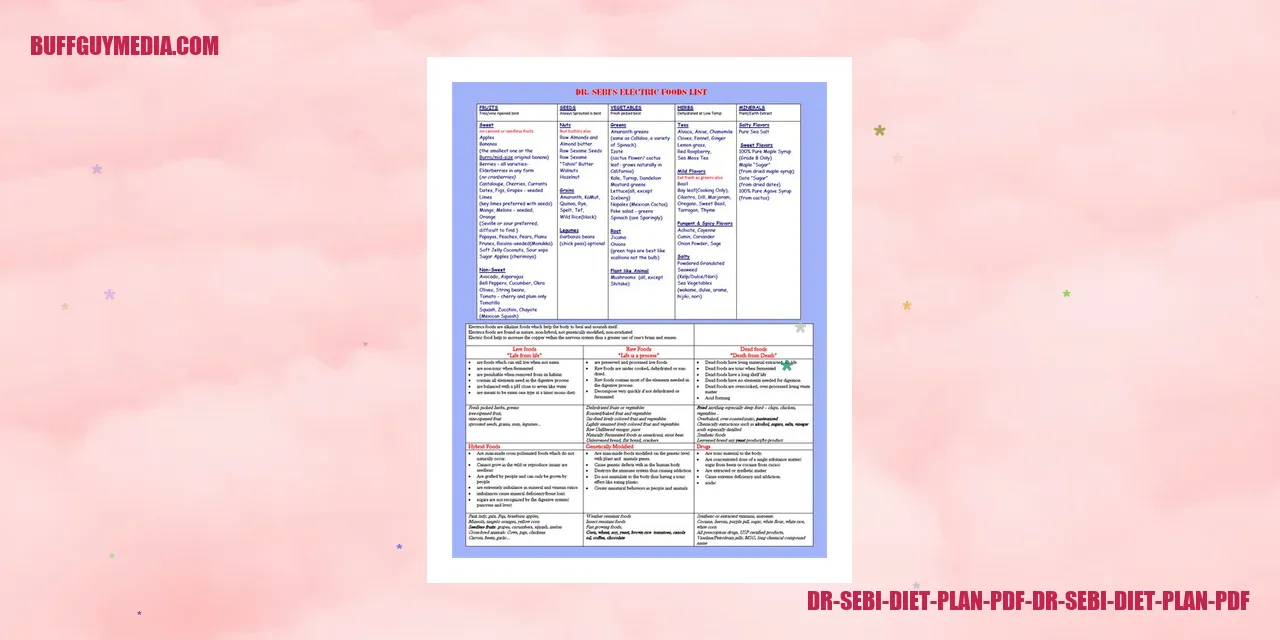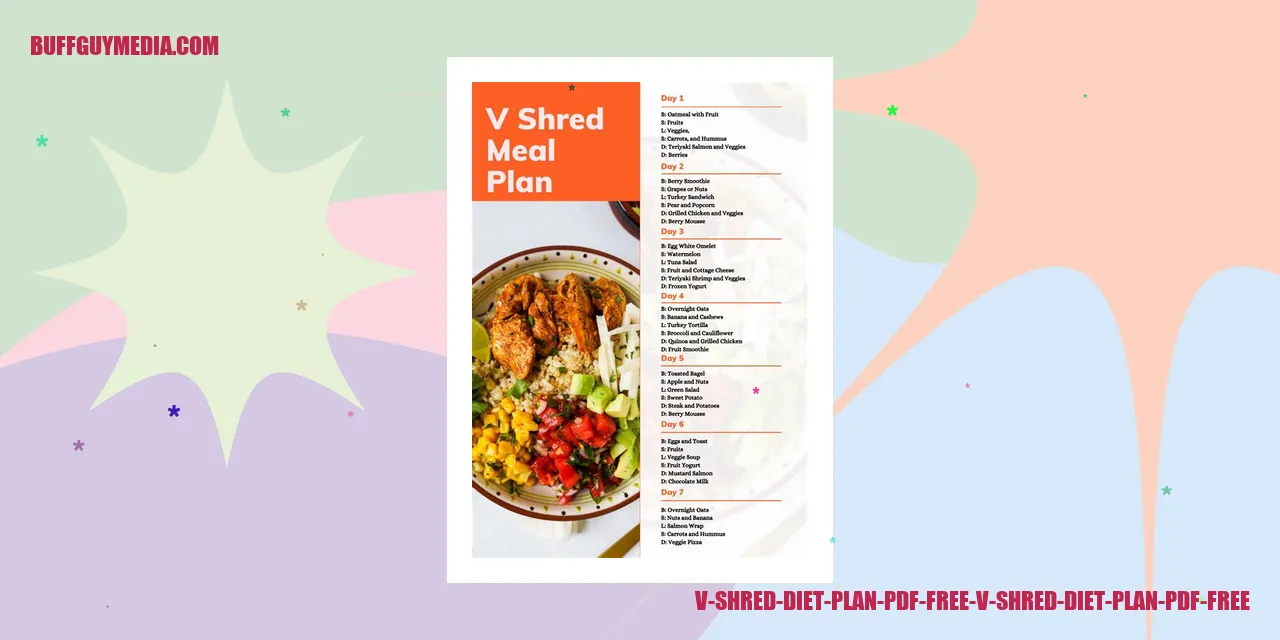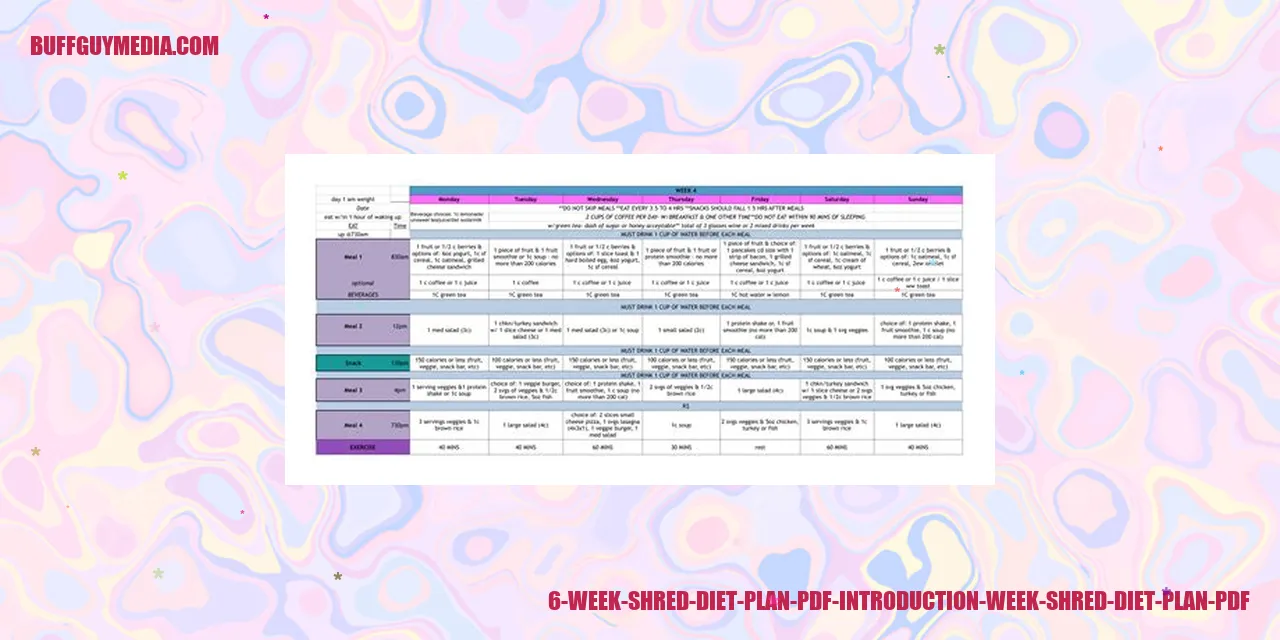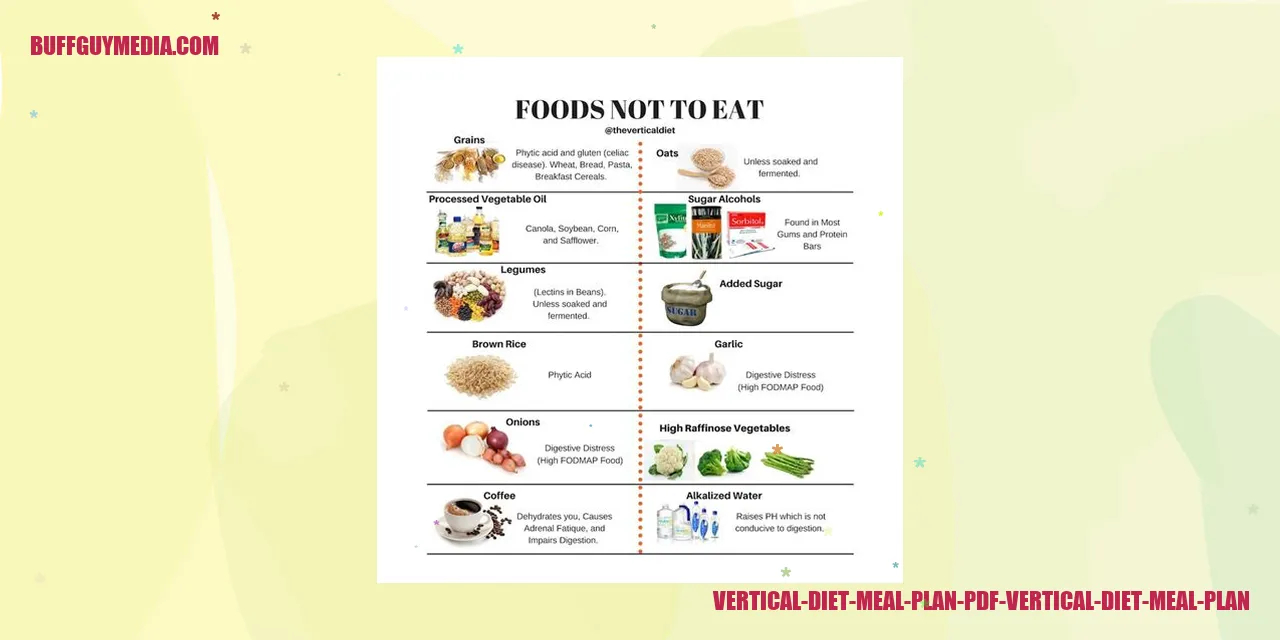Low Histamine Diet Plan PDF: A Comprehensive Guide for Managing Histamine Intolerance
The Low Histamine Diet Plan PDF: A Comprehensive Introduction
Understanding the Low Histamine Diet
The low histamine diet is a well-known dietary approach that aims to minimize the intake of foods that are rich in histamine. Histamine is a natural compound produced by the body and can also be found in various foods. However, for individuals with histamine intolerance, consuming these histamine-rich foods can lead to unpleasant symptoms such as headaches, hives, digestive issues, and nasal congestion.
By following the low histamine diet, individuals can effectively manage their histamine intolerance by avoiding or limiting the consumption of foods known to be high in histamine. This can lead to a significant alleviation of symptoms and an overall improvement in well-being.
The Benefits of a Low Histamine Diet
Embracing a low histamine diet offers several benefits for those with histamine intolerance. Firstly, it helps reduce the severity and frequency of symptoms associated with histamine intolerance, such as itching, flushing, and digestive discomfort.
In addition, this diet can contribute to better gut health by minimizing inflammation and promoting a healthy balance of gut bacteria. Excessive histamine levels in the body can contribute to the development of leaky gut syndrome, and adhering to a low histamine diet can mitigate this risk.
Moreover, individuals who follow a low histamine diet may also experience improved energy levels, better sleep, and enhanced cognitive function. By effectively managing their histamine levels, they can prevent the negative effects commonly associated with histamine intolerance.
How a Low Histamine Diet Can Address Histamine Intolerance
The low histamine diet is a highly effective method for managing histamine intolerance. By avoiding high-histamine foods, individuals can significantly reduce the overall histamine load in their bodies. This reduction in histamine intake eases the burden on the body’s natural histamine degradation pathways, enabling it to efficiently eliminate excess histamine.
In addition to eliminating high-histamine foods, some individuals may find it beneficial to exclude foods that liberate histamine or inhibit the enzyme responsible for breaking down histamine. This may include avoiding alcohol, certain spices, and medications like non-steroidal anti-inflammatory drugs (NSAIDs).
It is essential to note that the adoption of a low histamine diet should be done under the supervision of a healthcare professional. This ensures proper nutritional planning and helps prevent any potential nutrient deficiencies.
Top Tips for Initiating a Low Histamine Diet
If you are considering starting a low histamine diet, here are some practical tips to help you get started:
- Conduct thorough research and acquaint yourself with high-histamine foods that need to be avoided.
- Gradually eliminate high-histamine foods from your diet to minimize withdrawal symptoms and facilitate a smooth transition.
- Maintain a food diary to monitor your symptoms and identify specific trigger foods.
- Consult with a registered dietitian or healthcare professional specializing in histamine intolerance to ensure your nutritional needs are met.
- Experiment with alternative ingredients and cooking techniques to add variety and flavor to your meals while adhering to the low histamine diet.
[[READMORE]]
Also read:
Weight Gain Simulator – Reach Your Ideal Weight with Ease
Discover an Array of Salad Recipes to Nurture Your Healthy Obsession
By incorporating these tips into your routine and being mindful of your individual sensitivities, you can successfully implement a low histamine diet and effectively manage histamine intolerance.

Essential Foods to Incorporate in a PDF for Low Histamine Diet Plan
Opting for Low Histamine Foods
A low histamine diet can be highly beneficial for individuals who experience histamine intolerance or sensitivity. Histamine, a naturally occurring chemical in the body, can trigger allergic-like reactions when certain foods are consumed. To alleviate symptoms like headaches, hives, nasal congestion, and digestive issues, following a low histamine diet is crucial.
When adhering to a low histamine diet, it is essential to include foods that have low histamine levels. Fresh fruits and vegetables, lean meats and fish, as well as healthy fats and oils, are excellent options to consider.
Enrich Your Plate with Fresh Fruits and Vegetables
Fresh fruits and vegetables are ideal choices when following a low histamine diet. Apples, pears, berries, broccoli, cauliflower, spinach, and kale are just a few examples of low histamine options. It is important to select fresh produce and avoid overripe or spoiled ones as they tend to have higher histamine levels.
Including a variety of colorful fruits and vegetables in your diet not only keeps histamine levels in check but also provides essential vitamins, minerals, and antioxidants.
Selecting Lean Meats and Fish
Lean meats and fish play a vital role in a low histamine diet. Opt for chicken breast, turkey, lean cuts of beef, and fresh fish like salmon, cod, or haddock. It is advisable to cook these proteins fresh and avoid aged or cured meats as they often contain higher histamine levels.
Incorporating these lean protein sources into your meals helps maintain a well-balanced diet while minimizing histamine exposure.
Incorporating Healthy Fats and Oils
Addition of healthy fats and oils in your low histamine diet can further enhance the nutritional value. Opt for oils like olive oil, coconut oil, or avocado oil, as they are considered low in histamine. These oils can be used for cooking or dressing meals, providing flavor and nourishment without contributing to high histamine levels.
Avoiding refined vegetable oils and margarine is crucial as they can trigger histamine release and worsen histamine intolerance symptoms.
Following a low histamine diet plan may present challenges, but it is achievable with careful food selection and preparation. Always consult a healthcare professional or registered dietitian before making significant dietary changes, especially if you suspect histamine intolerance.
Remember to listen to your body and personalize the low histamine diet plan based on your specific needs, as everyone’s tolerance to histamine can differ.
Foods to Exclude in a Low Histamine Diet Guide PDF

High Histamine Foods
When following a low histamine diet plan, it is crucial to steer clear of consuming foods that contain high levels of histamine. These are food items that have gone through an aging or fermentation process, consequently raising the histamine levels within them. Notable examples of such foods include matured cheeses, such as blue cheese, cheddar, and Parmesan. Furthermore, smoked or cured meats like salami and sausages, as well as fermented beverages like red wine and beer, are also considered high histamine foods.
Fermented and Aged Foods
Foods that have undergone natural fermentation and aging processes are infamous for their elevated histamine content. In order to adhere to a low histamine diet plan, it is advisable to limit the consumption of fermented and aged foods. This includes products like yogurt, kombucha, sauerkraut, soy sauce, and pickles. Despite their popularity due to their probiotic properties, individuals sensitive to histamine may experience adverse reactions after consuming these foods.
Processed and Canned Foods
Processed and canned foods are frequently associated with increased histamine content. These food items commonly contain artificial preservatives and flavor enhancers, both of which can contribute to histamine intolerance. It is recommended to refrain from consuming processed meats like hot dogs, sausages, and canned fish such as tuna and sardines, as they are more likely to contain higher histamine levels. Additionally, ready-to-eat meals and packaged snacks should be avoided to minimize the intake of histamine-inducing additives.
Food Additives and Preservatives
Food additives and preservatives are potential triggers of histamine-related symptoms. Certain food colorings, flavor enhancers like monosodium glutamate (MSG), and artificial sweeteners have been linked to histamine intolerance. For individuals following a low histamine diet plan, it is essential to carefully read product labels and steer clear of foods containing these additives. Opting for fresh, organic food options whenever possible is also advised to reduce the exposure to potential substances that may trigger histamine intolerance.
In conclusion, adopting a low histamine diet plan can greatly benefit individuals who experience histamine intolerance. By avoiding high histamine foods, fermented and aged foods, processed and canned foods, as well as food additives and preservatives, individuals can lower the risk of histamine-related symptoms and enhance their overall well-being.

Effective Meal Planning for a Low Histamine Diet Plan
Helpful Tips for Meal Planning on a Low Histamine Diet
Embarking on a low histamine diet may appear daunting, but with proper meal planning, it becomes a manageable endeavor. Here are some valuable tips to assist you in crafting your meal plans:
1. Familiarize Yourself with Histamine Levels: Before mapping out your meals, acquaint yourself with the histamine content of various foods. This knowledge will aid you in avoiding high histamine foods while selecting suitable alternatives.
2. Plan Ahead: Take the time to create a weekly meal plan encompassing low histamine options. This will allow you to prepare ingredients in advance and maintain a well-balanced diet throughout the week.
3. Opt for Fresh Ingredients: Fresh fruits, vegetables, and proteins that have not undergone aging or fermentation generally contain lower levels of histamine. Include a diverse range of fresh ingredients in your meals to ensure a wide array of nutrients.
4. Embrace Homemade Cooking: By preparing meals at home, you gain control over the ingredients used, reducing the risk of consuming high histamine foods. Experiment with different cooking methods to preserve flavor while keeping histamine levels low.
5. Mind Cross-Contamination: If histamine sensitivity is a concern, it is crucial to avoid cross-contamination. Keep utensils, cutting boards, and surfaces clean while handling different foods to prevent histamine contamination.
A Sample Meal Plan for a Low Histamine Diet
Let’s delve into an example of a well-balanced meal plan for a day on a low histamine diet:
Breakfast:
– Quinoa porridge topped with fresh berries
– Herbal tea
Lunch:
– Grilled chicken breast
– Steamed broccoli
– Brown rice
– Cucumber salad with olive oil and lemon dressing
Snack:
– Rice cakes with hummus
– Carrot sticks
Dinner:
– Baked salmon with dill sauce
– Roasted sweet potatoes
– Sautéed spinach
Snack:
– Fresh fruit salad
Ideas for Snacks on a Low Histamine Diet
When following a low histamine diet, it’s crucial to have delicious and satisfying snack options. Here are some ideas suitable for a low histamine diet:
1. Fresh Fruit Variety: Indulge in an assortment of fresh fruits such as berries, melons, and apples.
2. Vegetable Sticks with Dips: Prepare crunchy carrot, cucumber, or celery sticks and pair them with low histamine dips like guacamole or homemade hummus.
3. Rice Cakes or Crackers: Opt for plain rice cakes or low histamine crackers for a light and crispy snack.
4. Nuts and Seeds: Enjoy low histamine nuts and seeds such as sunflower seeds or pumpkin seeds as a quick and nutritious snack.
5. Hard-Boiled Eggs: These nutrient-rich eggs make for an easy and wholesome snack option.
Recipe Resources for Low Histamine Meals
Discovering recipes that align with a low histamine diet can pose a challenge. However, here are some valuable resources to help you explore delicious low histamine meals:
1. Low Histamine Diet Cookbooks: Seek out cookbooks dedicated specifically to low histamine recipes. These cookbooks often provide detailed guidance on suitable ingredients and cooking techniques for a low histamine diet.
2. Online Recipe Websites: Explore websites such as “The Low Histamine Chef” or “Low Histamine Diet” that offer an extensive range of low histamine recipes. These resources can diversify your meal options and provide inspiration.
3. Engage in Social Media Groups: Join online communities or groups centered around low histamine diets. Members frequently share their favorite recipes and experiences, offering valuable insights to enhance your journey.
4. Consult a Professional: Consider engaging the expertise of a registered dietitian specializing in histamine intolerance. They can provide personalized meal plans and recommend recipes tailored to your specific needs.
By embracing these meal planning tips, utilizing sample meal plans, exploring snack ideas, and leveraging recipe resources, you can successfully adhere to a low histamine diet and effectively manage histamine intolerance. Always consult with a healthcare professional before making significant dietary changes to ensure it aligns with your individual requirements and needs.

Proactively Managing Symptoms on a PDF of Low Histamine Diet Plan
Recognizing Common Indications of Histamine Intolerance
Histamine intolerance is a condition that arises when the breakdown of histamine in your body is compromised, resulting in an excess buildup of this compound. This can manifest in a range of symptoms including throbbing headaches, debilitating migraines, troublesome skin rashes, nasal congestion and sneezing, digestive distress, and chronic fatigue. Familiarizing yourself with these symptoms is crucial, as they can significantly impact your overall well-being and daily functioning.
Maintaining a System for Tracking and Identifying Trigger Foods
A crucial step in effectively managing histamine intolerance is to identify and diligently avoid the consumption of trigger foods. Recording your meals in a dedicated food diary can prove invaluable in tracking potential symptoms and linking them to specific foods. Common culprits that are typically high in histamine include fermented food products, aged cheeses, cured meats, certain types of fish, and alcoholic beverages. Equally important is to be mindful of foods that can trigger the release of histamine in your body, such as citrus fruits, tomatoes, and spinach.
Tactics for Coping with Cravings for Restricted Foods
Following a low histamine diet plan often gives rise to cravings for foods that are off-limits. Successfully navigating these cravings requires finding suitable alternatives. For instance, if you find yourself longing for aged cheese, it may be worth exploring low histamine cheese options or experimenting with dairy-free alternatives. Don’t be afraid to venture into new recipes and ingredients to discover satisfying substitutes that align with your dietary restrictions.
Effective Strategies for Dining Out while Complying with a Low Histamine Diet
Adhering to a low histamine diet plan can pose challenges when dining out, as you have limited control over the ingredients used. However, there are strategies that can simplify the process. Prior to choosing a restaurant, conduct thorough research to find establishments that offer suitable options. Be open and communicate with the staff about your specific dietary needs, requesting them to accommodate your requirements. Opting for simple dishes such as grilled meats or fish with steamed vegetables often reduces the likelihood of histamine-related reactions. By staying prepared and proactive, you can successfully manage your histamine intolerance even when dining out.

Supplements and Medications for a Low Histamine Diet Plan PDF
Supplements that can support a low histamine diet
When following a low histamine diet plan, it is crucial to ensure that you are obtaining all the essential nutrients. While the main focus should be on consuming foods without histamine, certain supplements can also complement this dietary approach. Quercetin, vitamin C, and diamine oxidase (DAO) are commonly suggested supplements that may aid in reducing histamine levels in the body. These supplements function by either stabilizing mast cells or supporting the enzymatic processes involved in histamine breakdown. Nonetheless, it is essential to consult with a healthcare professional before starting any new supplements to guarantee their safety and efficacy.
Medications that can assist in managing histamine intolerance
Aside from dietary modifications and supplements, there are medications available that can assist in managing histamine intolerance. Healthcare professionals may prescribe antihistamines such as cetirizine and loratadine to alleviate symptoms associated with histamine intolerance, such as itching, sneezing, and hives. However, it is important to note that these medications only provide temporary relief and do not address the underlying cause of histamine intolerance. Consultation with a healthcare professional is crucial to determine the appropriate medication and dosage for your specific requirements.
Importance of seeking advice from a healthcare professional
When embarking on a low histamine diet plan and considering supplements or medications, it is highly recommended to seek advice from a healthcare professional. They can provide personalized guidance based on your specific health condition, medical history, and potential medication interactions. A healthcare professional can conduct comprehensive assessments, diagnose any underlying conditions contributing to histamine intolerance, and develop a tailored treatment plan. This ensures that your low histamine diet plan, supplemented with suitable medications or supplements, is safe, effective, and suitable for your individual needs.
The significance of an individualized approach
Each individual’s experience with histamine intolerance may vary, and it is crucial to adopt an individualized approach when managing this condition. What works for one person may not work for another, and self-diagnosis or self-medication can be risky. By seeking advice from a healthcare professional, you can receive an accurate diagnosis, appropriate recommendations, and ongoing support throughout your journey. This ensures that your low histamine diet plan, supplemented with the correct medications and supplements, effectively manages your histamine intolerance and improves your overall well-being.
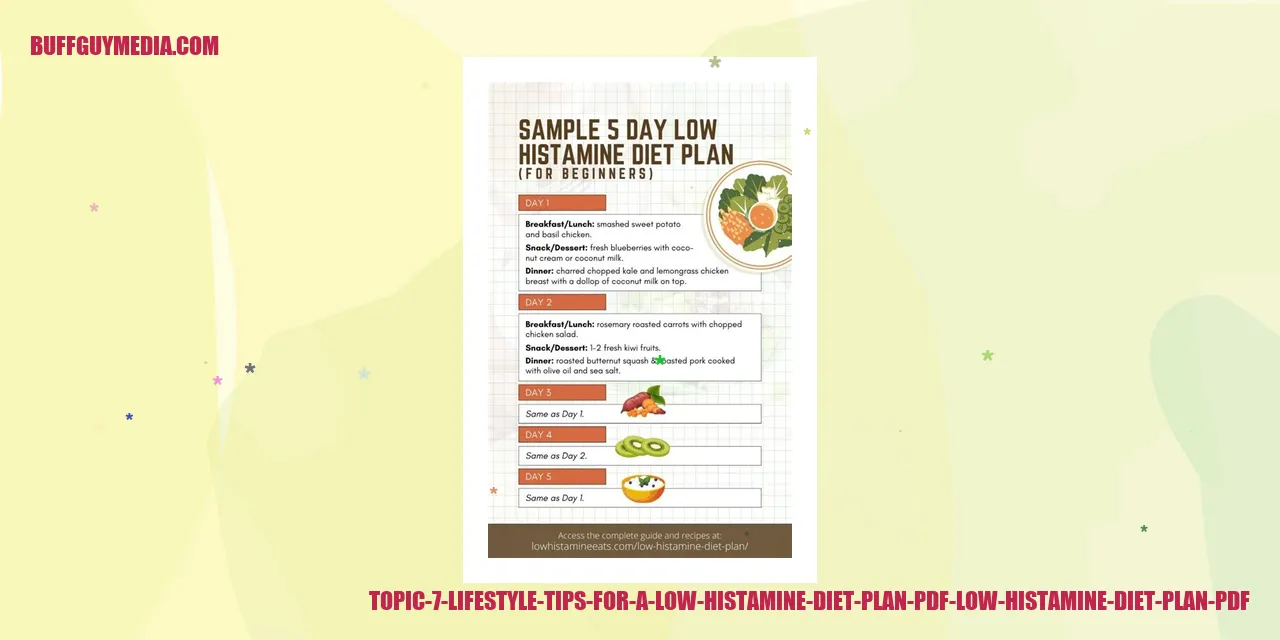
Optimizing Your Lifestyle for a Low Histamine Diet Plan PDF
Managing Emotional Well-being and Reducing Stress
When embarking on a low histamine diet plan, it is vital to prioritize emotional well-being and minimize stress levels. The connection between stress and worsening histamine intolerance symptoms cannot be ignored. Engaging in stress-relieving practices like meditation, deep breathing exercises, and mindfulness techniques can enhance emotional well-being, in turn supporting your overall health.
Physical Activity Recommendations and Exercise
Regular physical activity plays a pivotal role in managing histamine intolerance. Participating in moderate-intensity exercises such as brisk walks, swimming, or cycling can help regulate histamine levels within your body. It is crucial to tailor your exercise routine to suit your individual needs and abilities for optimum results.
The Impact of Sleep Hygiene on Histamine Intolerance
Ensuring adequate sleep is essential in maintaining optimal health and effectively managing histamine intolerance. By establishing a consistent sleep schedule, creating a comfortable sleep environment, and incorporating relaxation techniques into your bedtime routine, you can significantly enhance your sleep quality and alleviate histamine intolerance symptoms.
Awareness of Environmental Triggers and Allergens
Being mindful of environmental triggers and allergens is key to successfully managing a low histamine diet plan. Pollen, dust mites, pet dander, and certain chemicals are common culprits. Employing preventive measures such as using air purifiers, regularly cleaning living spaces, and avoiding known allergens can effectively minimize histamine intolerance symptoms.
Remember, embarking on a low histamine diet plan is a personal endeavor. It is essential to consult with healthcare professionals or registered dietitians before making significant changes to your diet and lifestyle. By incorporating these lifestyle tips into your routine, you can support your low histamine diet plan and promote overall well-being.
The Advantages of Meal Preparation and Batch Cooking for a Low Histamine Diet
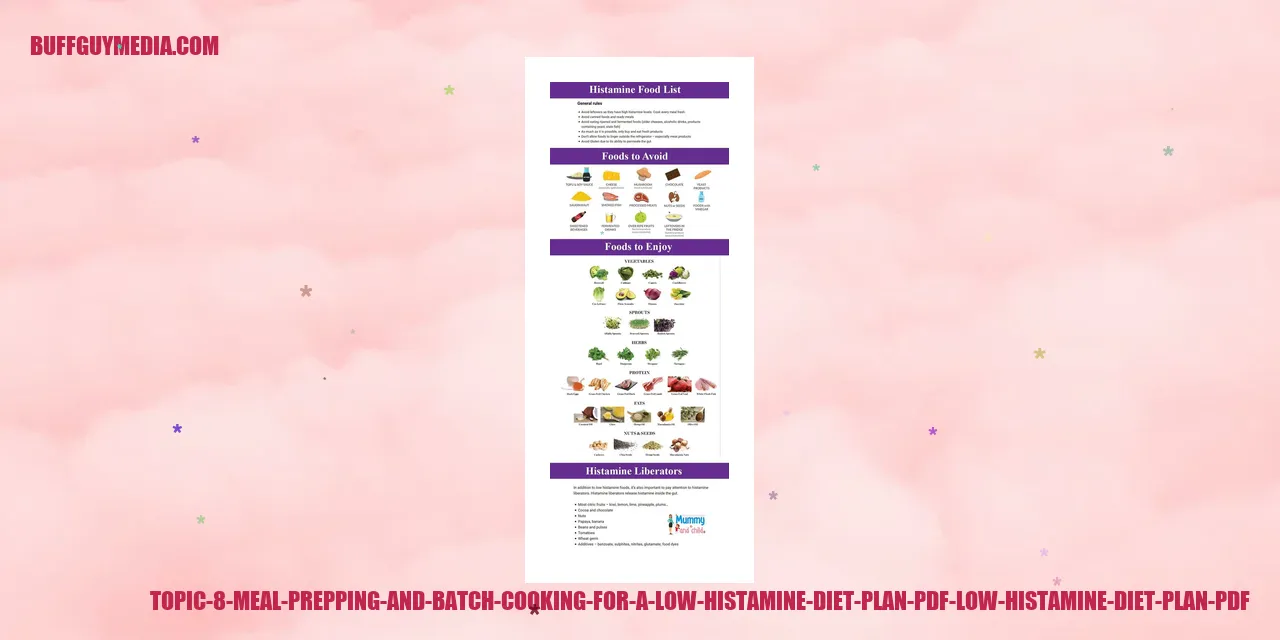
The Benefits of Meal Prepping and Batch Cooking
In recent years, meal prepping and batch cooking have become increasingly popular due to their numerous advantages. When it comes to adhering to a low histamine diet plan, these techniques offer several benefits that can greatly enhance your dietary journey.
One considerable advantage of meal prepping and batch cooking is the ability to save time and effort in the kitchen. By dedicating a specific day to meal preparation, you can cook multiple meals in one go, efficiently utilizing your time and reducing the daily cooking workload during busy workweeks. This also means fewer visits to the grocery store and less time spent on meal planning.
In addition to time-saving benefits, meal prepping and batch cooking can aid in maintaining a low histamine diet. By preparing your meals ahead of time, you have better control over the ingredients used, ensuring that all your meals are suitable for your dietary needs. This is particularly crucial for individuals with histamine intolerance, as it requires careful selection and avoidance of specific foods.
Techniques for Meal Prepping in a Low Histamine Diet
When it comes to meal prepping for a low histamine diet, employing several techniques can make the process more efficient and seamless.
Start by planning your meals in advance for the upcoming week. This step will help you create a comprehensive grocery list and ensure you have all the necessary ingredients readily available. Include a diverse range of low histamine foods, such as fresh fruits and vegetables, lean proteins, and whole grains.
Next, allocate a specific day or time for your meal prepping activities. Whether it’s a weekend day or a day that suits your schedule, dedicate a few hours to batch cooking multiple meals. Divide the prepped meals into portion sizes that best fit your needs, and store them in airtight containers. Make sure to label each container with the meal and date to monitor freshness.
Storage and Reheating Guidelines
Proper storage and reheating practices are crucial when meal prepping for a low histamine diet. Follow these guidelines to maintain the quality and safety of your prepped meals:
– Allow cooked meals to cool entirely before refrigerating or freezing them.
– Store your meals in airtight containers to prevent cross-contamination and maintain freshness.
– Label each container with the meal and date to ensure the meals are consumed within a safe timeframe.
– When reheating, verify that the internal temperature reaches at least 165°F (74°C) to eliminate any potential bacteria or pathogens.
Meal Prepping Tools and Resources
To enhance your meal prepping and batch cooking experience, consider investing in some helpful tools and resources.
Meal planning apps or websites can be useful tools for generating recipes, creating shopping lists, and keeping track of your dietary needs. A kitchen scale can also come in handy for precisely portioning out your meals.
Furthermore, explore low histamine recipe books or online communities catering to individuals with histamine intolerance. These resources can provide inspiration and guidance to create delicious meals that align with your low histamine diet plan.
In conclusion, meal prepping and batch cooking offer valuable techniques for individuals following a low histamine diet plan. These methods provide various benefits, including time-saving advantages, greater control over ingredients, and increased adherence to dietary needs. By following proper storage and reheating guidelines and utilizing helpful tools and resources, you can successfully incorporate meal prepping and batch cooking into your low histamine diet plan and enjoy flavorful, nutritious meals throughout the week.
Frequently Asked Questions (FAQ) regarding the Low Histamine Diet Plan PDF

What is the significance of histamine intolerance?
Histamine intolerance refers to the inability of the body to effectively break down histamine, which is present in various foods and naturally produced by the body. Elevated levels of histamine can give rise to a wide range of symptoms, such as headaches, skin rashes, digestive problems, and more. A low histamine diet is designed to reduce consumption of foods rich in histamine and alleviate these symptoms.
How soon can one expect improvements on a low histamine diet?
The timeframe for experiencing improvements on a low histamine diet can differ from person to person. While some individuals may begin to notice relief within a few days, others may require several weeks or even months to observe significant changes. It is worth noting that each individual’s body is unique, and finding the right balance of foods while avoiding triggers might require some experimentation.
Is it possible for children to follow a low histamine diet?
Children can indeed adopt a low histamine diet; however, it is advisable to seek guidance from a healthcare professional or a registered dietitian who specializes in pediatric nutrition. These experts can provide valuable insights into selecting appropriate foods that fulfill a child’s nutritional requirements while avoiding triggers that may induce symptoms.
Can vegetarians or vegans adhere to a low histamine diet plan?
Absolutely! A low histamine diet can be customized to cater to the needs of vegetarians or vegans. Although certain sources of histamine, such as specific types of meat and fish, are commonly known to be restricted, there is a wide variety of other plant-based alternatives available. It is of utmost importance to ensure a well-rounded and balanced diet that encompasses all essential nutrients.


